Night Trains in Europe: Here’s what you need to know before you book
Overnight trains in Europe can be a way to save money and also maximize your sightseeing time, but until you’ve booked and ridden on one of them, they can be quite mysterious. Night trains (as they are usually called) operate within their own network, and there are many important quirks in the system that are important to know.
I frequently get questions about whether a night train is a good option for travel around Europe, especially from those who are deciding on buying a Eurail Pass or not. The answers can be complicated, so I decided to cover as much of it as possible below, and make it easy to scan so you don’t have to read the whole thing. If you have additional questions, feel free to ask in the comments and I’ll take a shot at answering.
How night trains in Europe work (this is important)
The massive network of European trains goes at very regular intervals during the day, but the “night trains” are a separate network that operates in a very different way. It’s common that a specific train/route leaves every hour or two starting after about 06:00, but departures usually stop at the point when the last train can arrive by about 23:00. In other words, if it’s a 6-hour journey from one city to the end of the line, the last one will leave around 17:00 and arrive around 23:00.
After the day trains stop departing, the night trains take over, but usually with only one or two departures for the whole evening. So you might have trains departing hourly from 06:00 until 17:00, and then nothing until one train leaves at 21:00 and another leaves at 22:30, and then nothing departing until the next morning.
A hub and spoke network
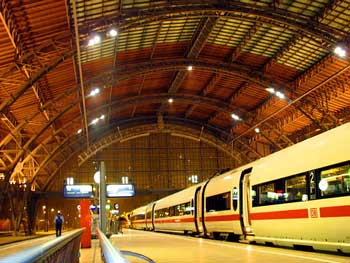
So let’s say you are taking a night train from Berlin to Amsterdam. The train leaving Berlin might have 10 carriages in tow, going to 4 or 5 different destinations. A few hours into the journey, the train will pull into a station and detach most of its carriages, which will then be hooked up to different engines for different destinations.
So not only is it critical that you are in the correct carriage in your assigned compartment, but there’s a very good chance that most of the other carriages in the train that pulls into Amsterdam the next morning will have started somewhere else the night before.
Should you go by night train in Europe? Here are factors to consider
Until you’ve actually taken night trains as part of a holiday, it’s easy to be confused as to whether they are a good choice or not. Below are the key points to help you decide.
Night trains can be cheaper than day trains, but check the fares
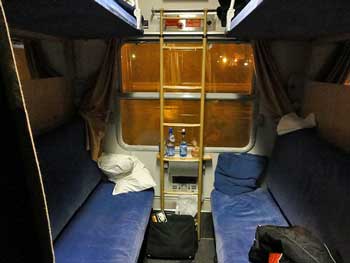
You have to reserve a seat or bunk on a night train when using a rail pass
More and more trains in Europe require that each passenger has a seat (or bunk) reservation, and this includes ALL night trains. If you are buying as you go then the seat or bed reservation will be included in the fare you are quoted, but if you are using a rail pass of some kind you’ll have to pay extra for that reservation.
For a seat the fee is usually around €5, but for a couchette it’s usually around €20 to €30, and for a Sleeper car bed it can be double that much.
On some of the most popular trains, like those running between France and Italy, the bunks can sell out a week or two in advance during high season. However, in most cases you’ll have no trouble reserving a seat or bunk just a day or two in advance, or even just an hour before the train leaves.
There are 4 types of seats or bunks to choose from on night trains
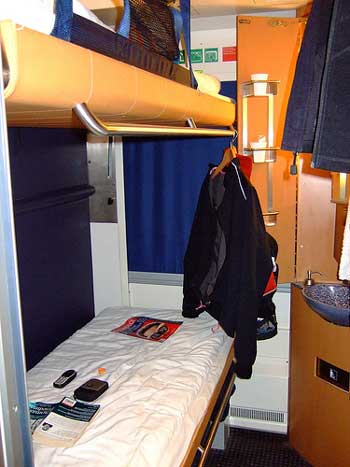
For most of us, the best option is either a couchette (pronounced KOO-shet), which is basically a padded bench that can be either 4 or 6 in a compartment. Or you can get a bed in a Sleeper carriage. These have anywhere from 1 to 4 beds in each compartment, and usually a wash basin. They are more comfortable, and of course they cost more.
In either a couchette or a Sleeper you will be provided with a sheet, blanket, and pillow. The couchettes are large and comfortable enough for most people, and chances are that if you can fall asleep in one, you could fall asleep in the other.
Night trains are best for rides between 500 and 800 kilometers
When people hear about night trains, they’ll often assume that they go between any two points, but of course this isn’t true. Night trains are always slower than day trains because of the spoke and hub system mentioned above, though if two cities are only 300 kilometers apart there probably isn’t a night train running because the journey is way too short for anyone to get real sleep on the thing in only 4 or 5 hours.
Now, there are many night trains scheduled that go up to 1,000 kilometers or even more, but they take 14 or more hours to get there, and that can be a brutally long trip. With few exceptions, it would be cheaper to fly between those cities. And since you miss most of the scenery anyway, a very long train ride doesn’t make any sense.
Night trains that take between 8 and 12 hours are usually the best because they are long enough to allow you to (at least try to) sleep, but not so long that you get restless and really sick of the journey.
Sleeping on night trains isn’t easy for everyone
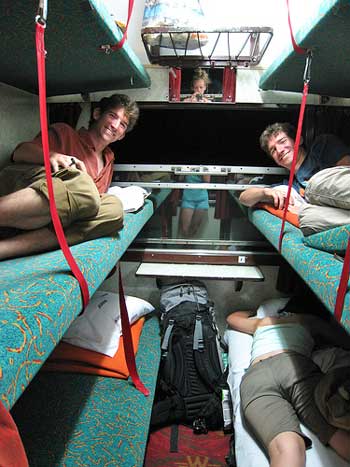
Even if you can sleep soundly on an airplane, you might struggle on a train because the bouncing and shifting can come and go. There will also be the period in the middle of the night when the train is switching carriages going to different destinations, which is mostly silent until you hear and feel the loud boom when the carriage connects.
As a light sleeper myself, I struggle on night trains so I usually avoid them. The best some of us can do is to guzzle a bottle of wine as the train is pulling out, with the hopes of at least being knocked out for a few hours over the course of the journey.
Still, most people seem to have little or no trouble sleeping on these night trains.
Will you miss the scenery you’d see during the day?
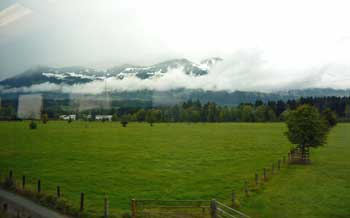
As pleasant as the scenery can be, it’s often not worth using up a sightseeing day to see it. In other words, will you get more out of a whole extra day in, say, Rome, than you would get by looking out the window on a daytime train from Rome to Nice? There’s no right answer, and it really depends on the route itself because much of Europe is actually quite boring out of a train window.
Generally speaking, the train views anywhere in or near the Alps are incredible, and the same is true for lesser mountain ranges. If a train route goes along the water it can also be one not to miss. Most of Italy is quite scenic as well. But most of northern Europe (north of the Alps) is flat as a pancake, and the daytime view is usually farm land and a nearby highway. So in those areas, don’t worry at all about missing the view.
A night train can save the cost of a hotel or hostel, but not always
The most famous and compelling argument in favor of night trains is that they save you the cost of a hotel room or hostel bed, so you have more to spend on sightseeing and whatnot. In some cases this is true, but even when it is it usually comes at a price.
Back to the discussion near the top of train pricing in Europe, a night train can be cheaper than a day train, even with the cost of a couchette factored in, but not always. In many cases the price will be the same, except that you’ll have to pay about €20 to €30 more for a couchette instead of a regular seat. In those cases it ends up being about the same price as a hostel bed or a cheap double hotel room split between two people. And chances are you won’t sleep nearly as well on the train compared to the stationary options.
Are the awkward departure and arrival times worth it?
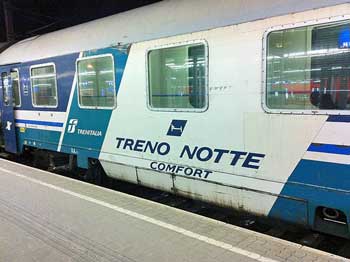
There have been several times when my train has arrived at 08:00 after getting very little sleep during the journey, so I’m left to stumble around town in the same clothes I slept in, and without a shower, for maybe 5 hours before I can check in and take a little nap to catch up on sleep. Most of those experiences turned out to be fun and interesting anyway, but I still only do that once in awhile.
The point here is that the specific departure and arrival times are another thing to consider when you are deciding between a day train, night train, or even a flight. And the notion of taking night trains on back to back nights is insane for most of us if we have nowhere to shower and rest during the day.
How to check schedules and fares on night trains in Europe
Unfortunately, checking schedules and fares on any international train in Europe is more complicated than you’d think at this point. There are two main options to consider in the early research phase, but both have challenges.
First one to check
or
The two sites above are run by a long-established company that is controlled by the France and Swiss rail companies. The great thing about them is that they do a great job of showing all the good train options with all the details for pretty much any train journey in Europe. The not so great thing is that they list higher prices for every trip than you’d find if you were searching for the same thing on the official rail site in each country.
So if you are looking for night train (or any train) schedules, they are the best place to start your search. They also have great customer service and they offer free shipping on orders over US$400 to most of the world. But they do charge maybe 20% more than you’d pay on another site, and the ease of use, customer service, and free shipping might or might not make that worthwhile to you.
Second one to check
Once you know about a train journey you might want to buy online, the best place to confirm it and book it at a lower fare is the powerhouse website of Deutsche Bahn (German Rail). They list most train schedules all over Europe, including those that don’t go anywhere near Germany itself. Wherever you are going, this one is worth a look, and if you get lucky you might even be able to book your train straight away.
The bad news about Bahn.de is that they list pretty much EVERY possible combination of trains between one place and another, and it gets far more confusing than you’d imagine. While RailEurope.com generally shows the trains that people would consider, Bahn.de shows those alongside many other options that might include as many as 5 or 6 train changes for an otherwise simple route. Try it and you’ll see that it often leads to more questions than answers.
How and when to book night trains in Europe
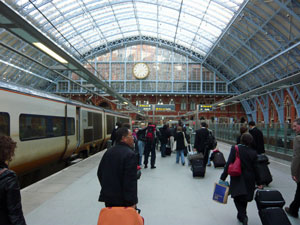
In some cases you can book these tickets on Bahn.de as well, but often you can’t. Different European countries start selling train tickets different amounts of time in advance. In France it’s 4 months out, while in Switzerland it’s only 1 month out, for example. And some countries authorize Bahn.de to sell their tickets, while others don’t. If your train trip involves Germany then you should be fine, but if it is elsewhere you might want to try the official rail site of one or both of the countries involved.
To find the official rail sites for these countries you can just Google “(country) rail site” and it will usually be the 1st or 2nd result. Beware of websites that are trying to look like official sites that aren’t.
When to book night trains
As with most other train trips in Europe, most night trains now work more on a discount airline model, where fares start low and they keep going up as more seats are sold. As each train gets close to being sold out, the fares can get so high that flying often becomes cheaper.
So the bottom line is that you should book these trains as early as possible for the best fare. Some are available as long as 6 months in advance, while others are only sold starting 1 month out. You need to check with the official rail site for your specific journey, although RailEurope.com should also have this info.
- France rail official site
- Italy rail official site
- German rail official site
- Netherlands rail official site
- Spain rail official site
- Sweden rail official site
- Denmark rail official site
When to make reservations on night trains using a rail pass
Using a Eurail Pass isn’t necessarily the cheapest way to travel the rails in Europe, but it almost always gives you the most flexibility. The fare of a particular night train might start out at €50 and then go up to €150 for the last few people to buy tickets. If you are using a rail pass, the only thing you care about is if there are any places left at all, so you can usually make up your mind just before you want to leave and you’ll be okay.
A “seat reservation” on a night train is mandatory and usually costs around €5 in 1st or 2nd Class seats, while a couchette (bunk) will usually cost €20 to €30 and a Sleeper bed more like €40 to €60 for the reservation. You can make reservations in person at the ticket office at the train station (or any other train station in that country), and you can also make a reservation on the same website where you bought your rail pass, for a slightly higher fee.
How far in advance to book?
As mentioned, you can usually reserve a bunk on a night train on the same day the train is scheduled to leave. Most of these trains pull out of the station with empty bunks, sometimes dozens and dozens of empty bunks. But during holiday periods or on extremely popular night train routes (between France and Italy), they might actually sell out a week or more in advance.
When people ask me how far in advance they should make their reservations for day trains, I typically reply that you can usually do it on departure day or the day before, but with night trains that can be more of a gamble. Since day trains tend to leave every hour or so, you can almost always find a seat if you are willing to go closer to the middle of the day rather than first thing in the morning. But with night trains, you’ll usually only have one or two options, and once those are sold out you can be stuck.
I prefer to reserve my night trains at least 2 or 3 days in advance, and so far I’ve never had a problem. If I had a flight or some other event that can’t be moved, I’d probably book even earlier. It all comes down to how flexible you are able to be, and what your back-up plan would be if you get unlucky and the one you want is sold out.
Photo credits: Top by Nikos Roussos on Flickr, Couchettes by Steven Vance on Flickr, Couchette travelers by ramblingrovers on Flickr, Italy train by andynash on Flickr, German Sleeper compartment by Platform 3 on Flickr, night train station by Uwe Hermann on Flickr

Excellent guide and the pictores are so helpful. I want to book 4 tikets for 4 diferent destination in a sleeper but I´ve been trying for a hole day and the best I could find is only seating. I´m from Paraguay and I supose there´s no need problem, I can book and print every ticket from here, right?
Karina,
Each county operates its own train system, so each country is a bit different. But as far as I’m aware, all of the systems now allow electronic tickets that you can buy and print out at home, and most of them also allow tickets on smart phones. So you can buy a ticket and when the conductor comes by to check it, you just show them the ticket on your smart phone and you don’t even need a physical copy. If you aren’t sure of something then let me know which country you are buying from and I’ll try to help more. -Roger
Excellent guide to the pluses and minuses of taking night trains. The photos give a good feel for what to expect too. I might try 1 or 2 on my upcoming interrail trip, for the experience more than anything!
i just wanna tell u that i love ur website its very helpful
thanks for doing this